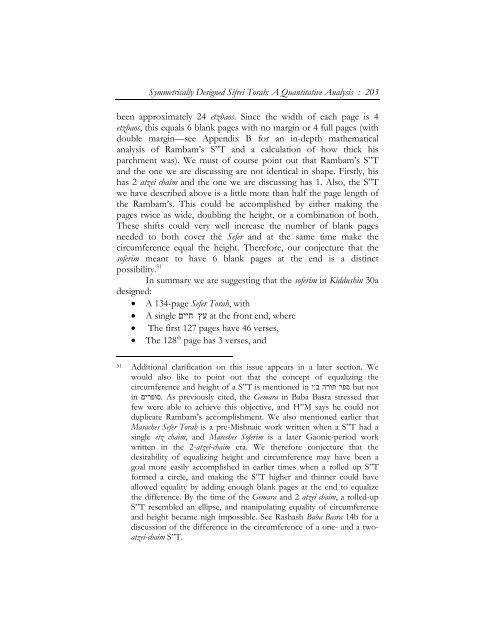Symmetrically Designed Sifrei Torah: A Quantitative Analysis - Hakirah
Symmetrically Designed Sifrei Torah: A Quantitative Analysis - Hakirah
Symmetrically Designed Sifrei Torah: A Quantitative Analysis - Hakirah
You also want an ePaper? Increase the reach of your titles
YUMPU automatically turns print PDFs into web optimized ePapers that Google loves.
<strong>Symmetrically</strong> <strong>Designed</strong> <strong>Sifrei</strong> <strong>Torah</strong>: A <strong>Quantitative</strong> <strong>Analysis</strong> : 203<br />
been approximately 24 etzbaos. Since the width of each page is 4<br />
etzbaos, this equals 6 blank pages with no margin or 4 full pages (with<br />
double margin—see Appendix B for an in-depth mathematical<br />
analysis of Rambam’s S”T and a calculation of how thick his<br />
parchment was). We must of course point out that Rambam’s S”T<br />
and the one we are discussing are not identical in shape. Firstly, his<br />
has 2 atzei chaim and the one we are discussing has 1. Also, the S”T<br />
we have described above is a little more than half the page length of<br />
the Rambam’s. This could be accomplished by either making the<br />
pages twice as wide, doubling the height, or a combination of both.<br />
These shifts could very well increase the number of blank pages<br />
needed to both cover the Sefer and at the same time make the<br />
circumference equal the height. Therefore, our conjecture that the<br />
soferim meant to have 6 blank pages at the end is a distinct<br />
possibility. 51<br />
In summary we are suggesting that the soferim in Kiddushin 30a<br />
designed:<br />
• A 134-page Sefer <strong>Torah</strong>, with<br />
• A single עץ חיים at the front end, where<br />
• The first 127 pages have 46 verses,<br />
• The 128 th page has 3 verses, and<br />
51 Additional clarification on this issue appears in a later section. We<br />
would also like to point out that the concept of equalizing the<br />
circumference and height of a S”T is mentioned in ספר תורה ב׃י but not<br />
in .סופרים As previously cited, the Gemara in Baba Basra stressed that<br />
few were able to achieve this objective, and H”M says he could not<br />
duplicate Rambam’s accomplishment. We also mentioned earlier that<br />
Masaches Sefer <strong>Torah</strong> is a pre-Mishnaic work written when a S”T had a<br />
single etz chaim, and Maseches Soferim is a later Gaonic-period work<br />
written in the 2-atzei-chaim era. We therefore conjecture that the<br />
desirability of equalizing height and circumference may have been a<br />
goal more easily accomplished in earlier times when a rolled up S”T<br />
formed a circle, and making the S”T higher and thinner could have<br />
allowed equality by adding enough blank pages at the end to equalize<br />
the difference. By the time of the Gemara and 2 atzei chaim, a rolled-up<br />
S”T resembled an ellipse, and manipulating equality of circumference<br />
and height became nigh impossible. See Rashash Baba Basra 14b for a<br />
discussion of the difference in the circumference of a one- and a twoatzei-chaim<br />
S”T.
















